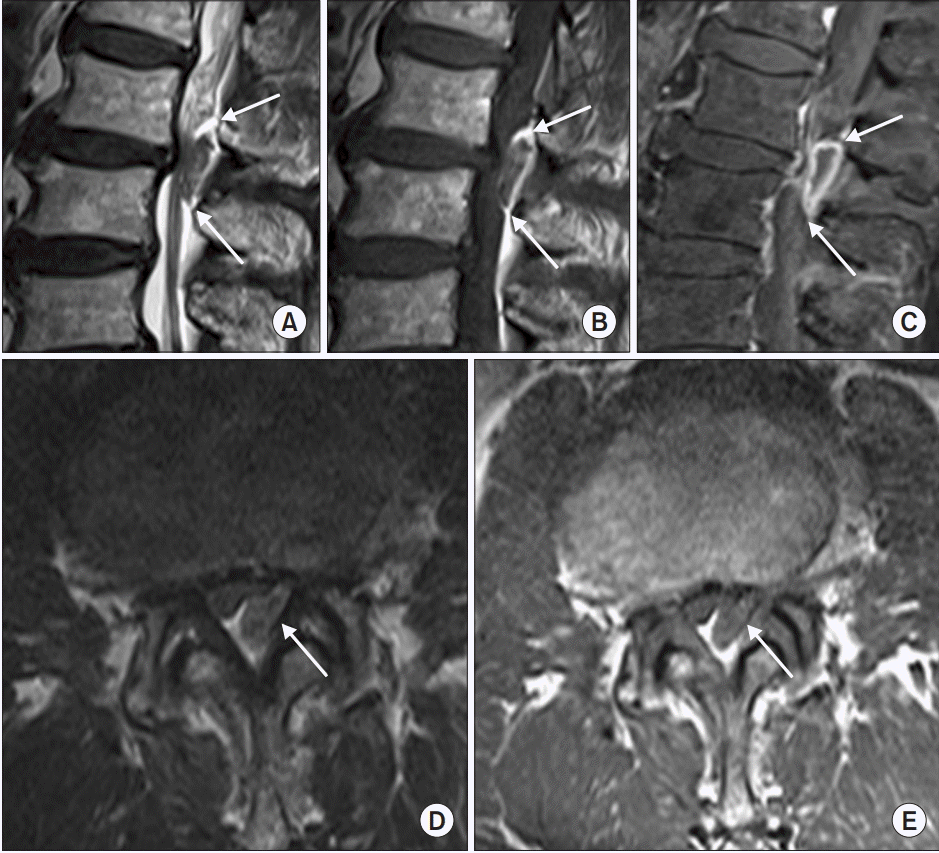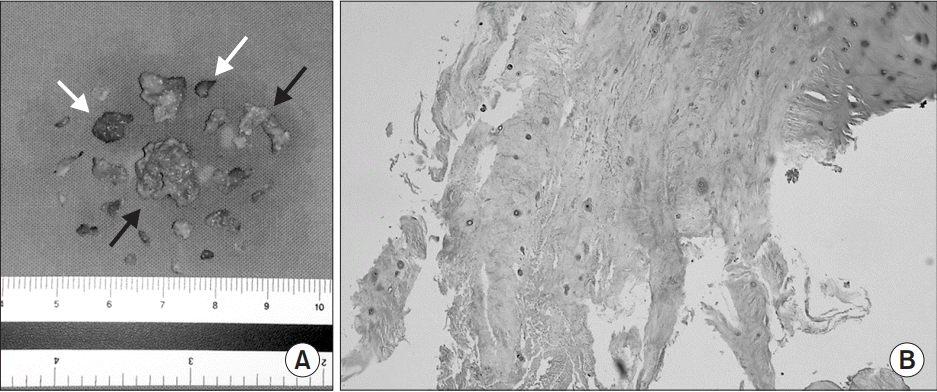Abstract
Posterior epidural migration of a lumbar intervertebral disc fragment (PEMLIF) is uncommon because of anatomical barriers. It is difficult to diagnose PEMLIF definitively because of its relatively rare incidence and the ambiguity of radiological findings resembling spinal tumors. This case report describes a 76-year-old man with sudden-onset weakness and pain in both legs. Electromyography revealed bilateral lumbosacral polyradiculopathy with a mass-like lesion in L2-3 dorsal epidural space on lumbosacral magnetic resonance imaging (MRI). The lesion showed peripheral rim enhancement on T1-weighted MRI with gadolinium administration. The patient underwent decompressive L2-3 central laminectomy, to remove the mass-like lesion. The excised lesion was confirmed as an intervertebral disc. The possibility of PEMLIF should be considered when rim enhancement is observed in the epidural space on MRI scans and electrodiagnostic features of polyradiculopathy with sudden symptoms of cauda equina syndrome.
Posterior epidural migration of a lumbar intervertebral disc fragment (PEMLIF) is uncommon because of anatomical barriers including the posterior longitudinal ligament, lateral membrane, and nerve root [1]. PEMLIF is difficult to diagnose definitively due to its rarity and radiological similarity to other epidural lesions [1], resulting in delay of appropriate treatment. Although magnetic resonance imaging (MRI) facilitates preoperative diagnosis of PEMLIF, the sequestered disc fragments can be misdiagnosed [2]. Here we report a case of PEMLIF resembling spinal tumor on MRI, which was diagnosed in the hyperacute stage using an electromyography, and treated with early surgical treatment.
A 76-year-old man presented with a 5-day history of progressive weakness and pain in both legs without lumbago. The pain was relieved when he bent his waist anteriorly. He had no history of trauma, weight loss, fever, or other constitutional symptoms. The patient had no past medical history related to peripheral neuropathy such as diabetes mellitus, malignancy, or other endocrine diseases. Physical examination revealed weakness in both legs. In the Medical Research Council manual muscle test, muscular weakness was observed in both lower limbs: hip flexor 4/4 (right/left), knee extensor 3/3-, ankle dorsiflexor 5/4, hallucis extensor 5/4, and ankle plan-tarflexor 5/5 grades.
The patient complained of tingling sensations, allodynia, and diminished pinprick and light touch sensation below L3 dermatome bilaterally. The patient had weak patellar and Achilles reflexes in both legs. The bulbocavernosus reflex (BCR) was absent and the anal tone was decreased but the patient had no bowel or bladder disturbances. Ankle clonus and Babinski sign were negative, and the straight leg raise test was positive bilaterally.
We suspected paraplegia due to lower motor neuron disease and performed electromyography. The nerve conduction study was normal except for late response: the F-wave showed no response in the common peroneal nerve; the H-reflex revealed no response in either gastrocnemius-soleus muscle. Needle electromyography showed reduced or single recruitment in the examined muscles with no abnormal spontaneous activity (Table 1). Evoked potential studies revealed spinal somatosensory and motor pathway dysfunction (Table 2): the somatosensory evoked potential revealed no response on the left posterior tibial nerve and latency delay on the right side [3]; motor evoked potential revealed latency delay on both sides of abductor hallucis [4]. Based on these findings, the patient was diagnosed with hyperacute lumbosacral polyradiculopathy. Therefore, based on the clinical investigations we suspected cauda equina syndrome (CES). We performed a lumbosacral MRI to determine the causes of the CES, and MRI revealed a mass-like lesion in L2-3 dorsal epidural space. The T2-weighted image (T2WI) showed a hyperintense lesion that was isointense and surrounded by hyperintense fat tissue on the T1-weighted image (T1WI) (Fig. 1). Additionally, the posterior thecal sac revealed a concave indentation due to compression from a mass. These radiographic features suggested epidural location of the lesion. Then, we performed a gadolinium contrast lumbosacral spine MRI to rule out diseases such as epidural neoplasm, abscess, and hematoma. The lesion showed peripheral rim enhancement on T1WI (Fig. 1C).
We initially suspected an epidural tumor diagnosis. The patient underwent decompressive laminectomy, to identify disc material at the dorsal thecal sac. We removed and confirmed the presence of fibrocartilage and chondrocytes in the disc material based on histopathological analysis (Fig. 2). The patient showed complete recovery of motor function and resolution of radicular pain on the third postoperative day.
The variable clinical presentation in PEMLIF ranges from low back pain without neurologic deficits to CES such as radiating pain in the legs, areflexia, sensory and motor disturbances, and bladder/bowel dysfunction [5]. Several reports suggested that the patient with CES had no bladder/bowel dysfunction [1,6,7]. The ambiguous clinical presentations complicate the early diagnosis. In a previous study, the period between the symptom onset and surgery was a major factor affecting postoperative improvement [8].
Electromyography facilitates the diagnosis of neural damage induced by PEMLIF in early stage. Our patient was subjected to electromyography on day 5 after the onset, which was obviously too early to determine the disease using electromyography alone. The electrodiagnostic evaluation of BCR and S2-4 myotome such as external anal sphincter was indicated. However, the patient complained of pain and inability to maintain his posture for the examination, which resulted in incomplete test. Instead, it was possible to identify S2-4 radiculopathy via physical examination such as absence of BCR and decreased anal tone. We concluded CES based on clinical manifestation and electrodiagnostic results. Based on the electrodiagnostic results suggesting incomplete nerve injury in the hyperacute stage, we predicted good prognosis with early decompressive treatment [8].
Radiological findings are essential to establish a diagnosis of PEMLIF. Computed tomography is useful but has limited utility in identifying the nature of lesions, due to less sensitivity and specificity than MRI [5]. MRI is considered the gold standard for diagnosis, and contrast-enhanced MRI facilitates the differential diagnosis of posterior epidural lesions [2,5,6,8]. Sequestered fragments usually show an isointense signal on T1WI and 80% yield a high signal on T2WI relative to the parent disc [9], and most disc fragments show peripheral rim enhancement on T1WI after gadolinium injection. The rim enhancement is believed to be an inflammatory response to granulation tissue and neo-angiogenesis around the avascular disc fragment [6]. Generally, T2WI images are of more interest than T1WI in clinical diagnosis. The T2WI findings for PEMLIF, however, fail to clearly determine the location of the lesion within or outside of the dura mater. In our case, based on the T1-weighted and gadoliniumenhanced images, our MRI findings suggested: (1) a concave indentation of the posterior thecal sac due to compression from a mass that is surrounded by hyperintense fat tissue on T1WI [5,8]; and (2) rim enhancement after gadolinium administration [5]. The first finding is particularly important suggesting that the lesion is located in the epidural space. Contrast-enhanced MRI is the best modality for differentiation of other epidural masses such as abscess, hematoma, and metastasis. The MRI findings for epidural abscess are similar to those for PEMLIF, but may be accompanied by irregular endplate margins as prominent features, as well as increased signals in the epidural fat corresponding to infection on T2WI [2]. Hematoma usually shows no rim enhancement on contrast-enhanced image and is associated with a history of trauma [8]. The epidural space is the most common site of metastasis [10]. While only 0.15%–4% of all symptomatic disc herniation occurs in the thoracic spine [9], the thoracic spine is the most common site (60%–70%), followed by the lumbosacral (20%–25%) and the cervical spine (10%–15%) for metastatic epidural tumor [10]. Contrast-enhanced MRI reveals uniform enhancement and additional changes such as vertebral pedicle erosion, and vertebral collapse in 70%–80% of metastatic epidural spinal cord compression [10].
In conclusion, the possibility of PEMLIF should be considered when rim enhancement is detected in the epidural space on MRI, and electrodiagnostic features of polyradiculopathy with sudden symptoms of CES. Early diagnosis leads to early surgery, which reduces complications and improves prognosis.
ACKNOWLEDGMENTS
This work was supported by a grant awarded by the National Research Foundation of Korea (NRF) funded by the Korean government (MSIP) (No. NRF-2017R1C1B5018006).
REFERENCES
1. Teufack SG, Singh H, Harrop J, Ratliff J. Dorsal epidural intervertebral disk herniation with atypical radiographic findings: case report and literature review. J Spinal Cord Med. 2010; 33:268–71.

2. Chen CY, Chuang YL, Yao MS, Chiu WT, Chen CL, Chan WP. Posterior epidural migration of a sequestrated lumbar disk fragment: MR imaging findings. AJNR Am J Neuroradiol. 2006; 27:1592–4.
3. Dumitru D, Amato AA, Zwarts M. Electrodiagnostic medicine. 2nd ed. Philadelphia: Hanley & Belfus Inc;2002.
4. Tobimatsu S, Sun SJ, Fukui R, Kato M. Effects of sex, height and age on motor evoked potentials with magnetic stimulation. J Neurol. 1998; 245:256–61.

5. El Asri AC, Naama O, Akhaddar A, Gazzaz M, Belhachmi A, El Mostarchid B, et al. Posterior epidural migration of lumbar disk fragments: report of two cases and review of the literature. Surg Neurol. 2008; 70:668–71.

6. Kim JS, Lee SH, Arbatti NJ. Dorsal extradural lumbar disc herniation causing cauda equina syndrome: a case report and review of literature. J Korean Neurosurg Soc. 2010; 47:217–20.
7. Toktas ZO, Yılmaz B, Konya D, Yapicier O, Demir MK. Posterior epidural migration of lumbar disc fragment as an unusual ring-enhancing mass. Spine J. 2016; 16:e31. –2.
8. Sengoz A, Kotil K, Tasdemiroglu E. Posterior epidural migration of herniated lumbar disc fragment. J Neurosurg Spine. 2011; 14:313–7.

Fig. 1.
Preoperative magnetic resonance imaging findings of the lumbar spine: a mass-like 2.3 cm lesion was detected at the L2-3 level in the posterior epidural space. The lesion (arrows) was hyperintense on sagittal and axial T2- weighted images (A, D) and isointense to the intervertebral disc on sagittal and axial T1-weighted images (B, E). The lesion showed rim enhancement (arrow) on sagittal gadolinium-enhanced T1- weighted image (C).

Fig. 2.
Gross appearance and photomicrograph of surgical specimen containing intervertebral disc fragment. (A) Gross specimen shows increased vascularized epidural tissue (white arrows) and degenerated intervertebral disc fragment tissue (black arrows). (B) Histopathologic findings show degenerated fibrocartilage (H&E, ×100).

Table 1.
Results of needle electromyographic studies




 PDF
PDF Citation
Citation Print
Print



 XML Download
XML Download